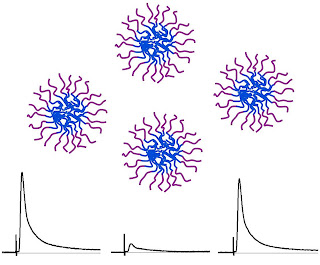WEST LAFAYETTE, Ind. - Researchers at Purdue University have discovered a new approach for repairing damaged nerve fibers in spinal cord injuries using nano-spheres that could be injected into the blood shortly after an accident.
The synthetic "copolymer micelles" are drug-delivery spheres about 60 nanometers in diameter, or roughly 100 times smaller than the diameter of a red blood cell.
Researchers have been studying how to deliver drugs for cancer treatment and other therapies using these spheres. Medications might be harbored in the cores and ferried to diseased or damaged tissue.
Purdue researchers have now shown that the micelles themselves repair damaged axons, fibers that transmit electrical impulses in the spinal cord.
In research led by biomedical engineering doctoral student Yunzhou Shi, the micelles also were shown to be non-toxic at the concentrations required.
"With the micelles, you need only about 1/100,000th the concentration of regular polyethylene glycol," Cheng said.
Ongoing research at Purdue has shown the benefits of polyethylene glycol, or PEG, to treat animals with spinal cord injuries. The work is led by Richard Borgens, director of the Center for Paralysis Research and the Mari Hulman George Professor of Neurology in the School of Veterinary Medicine.
Findings have shown that PEG specifically targets damaged cells and seals the injured area, reducing further damage. It also helps restore cell function.
The new findings were made possible by the interdisciplinary nature of the work, which involves Borgens and other Purdue researchers, Cheng said. The collaboration included Borgens; Riyi Shi, an associate professor of biomedical engineering and basic medical sciences; and Kinam Park, Showalter Distinguished Professor of Biomedical Engineering and a professor of pharmaceutics.
Findings showed that cores made of particular materials work better than others at restoring function to damaged axons, which are slender extensions of nerve cells.
The research also showed that without the micelles treatment about 18 percent of axons recover in a segment of damaged spinal cord tested in a "double sucrose gap recording chamber." The micelles treatment boosted the axon recovery to about 60 percent. The researchers used the chamber to study how well micelles repaired damaged nerve cells by measuring the "compound action potential," or the ability of a spinal cord to transmit signals.
The experiment mimics what happens during a traumatic spinal cord injury. Findings showed that micelles might be used to repair axon membranes damaged by compression injuries, a common type of spine injury.
The researchers also tracked dyed micelles in rats, demonstrating that the nanoparticles were successfully delivered to injury sites. Findings also showed micelles-treated animals recovered the coordinated control of all four limbs, whereas animals treated with conventional polyethylene glycol did not. ###
The Nature Nanotechnology paper was written by Yunzhou Shi, postdoctoral researcher Sungwon Kim of the Department of Industrial and Physical Pharmacy, chemistry graduate student Terry B. Huff, Borgens, Park, Rihi Shi and Cheng.
The work has been funded by a Showalter Trust grant from Purdue and a grant from the Indiana Spinal Cord and Brain Injury Research Fund, and is partially supported by the state of Indiana and an R01 grant from National Institute of Biomedical Imaging and Bioengineering.
Further research will include work to learn about the specific mechanisms that enable the micelles to restore function to damaged nerve cells.
Writer: Emil Venere, 765-494-4709, venere@purdue.edu Sources: Ji-Xin Cheng, 765-494-4335, jcheng@purdue.edu Kinam Park, 765-494-7759, kpark@purdue.edu
Contact: Emil Venere venere@purdue.edu 765-494-4709 Purdue University















No comments:
Post a Comment